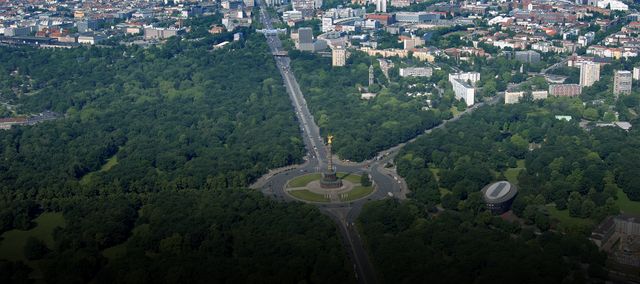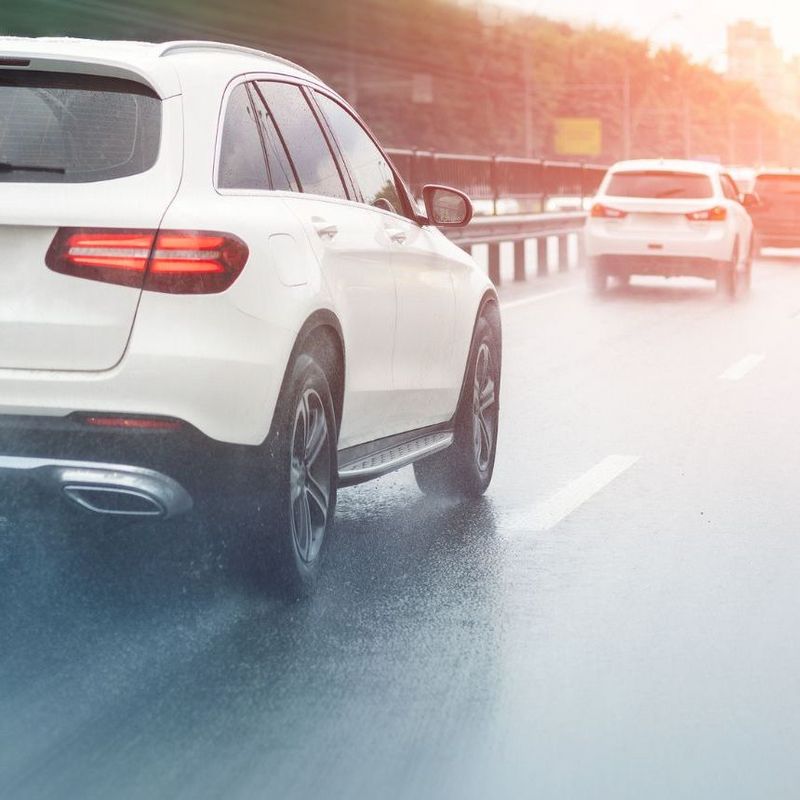4 October 2017
In the midst of the hurly burly of the capital’s traffic, a test route for autonomous driving and intelligent traffic management is under construction. For it is here that the future of mobility is undergoing a reality check. The safety standards are being monitored and reviewed by TÜV NORD.
This route embodies the spirit of Berlin like nowhere else in the capital. Heading along Friedrichstrasse from the former eastern part of the city and passing by the capital’s iconic landmark, the Brandenburg Gate, the driver ends up on the Strasse des 17. Juni, whose name bears witness to the popular uprising of 1953. The route continues through the parkland of the Tiergarten to the busy roundabout known as the Goldener Stern with its victory column on which the resplendently gilded angel of peace soars above the city. The route then proceeds along a six-lane carriageway past the Technical University to the equally large and busy roundabout that dominates Ernst-Reuter-Platz and which it is not uncommon for drivers to lap several times before finding their bearings and escaping from the tangle of traffic. Given all the stress of the chaotic traffic situation, it would hardly be surprising if the occasional driver were to dream of leaving the driving to the car. And this is not going to be pie in the sky for very much longer. This is because the historically significant Strasse des 17. Juni from the Brandenburg Gate to Ernst-Reuter-Platz is soon set to become a high-tech Mecca for traffic technologies.
© TU-Berlin/PressestelleThe safety driver monitors the test run. The Stadtpilot (Urban Pilot) project has the declared aim of autonomously travelling the Braunschweig ring road in normal traffic. TÜV NORD has been supporting the introduction of Stadtpilot.© TÜV NORD GROUPThe experience gained with the TÜV NORD eSTATION in Hanover is being incorporated into the DIGINET-PS project.
A pioneering project in the making
Cars without drivers are already being sent out onto motorways for testing. Although it has to be said that automated driving on these long-distance roads is relatively straightforward. The real challenge is city traffic with its often unpredictable conditions. Which is why this route of just under four kilometres in length will soon have its work cut out. “On the one hand, we want to build small computers at the roadside which cars can talk to. We’re kitting traffic lights out with additional sensors so that the on-board computers are directly informed as soon as the lights change to green. This will significantly improve traffic flow,” explains Prof. Sahin Albayrak in an interview with cult tech magazine Wired. Albayrak is a professor at the Technical University of Berlin, where he is in charge of the faculty entitled “Agent technology in operational applications”. On the other side, all the car parking spaces are to be fitted with the technology that allows road users to automatically detect and seek out free spaces. In addition to all of this, there will also be sensors along the route to collect environmental data; street lamps are to be fitted with an LED infrastructure and additional sensors for smart lighting purposes. A pioneering project for smart traffic networking and autonomous driving in urban traffic – the first of its kind in Germany.
“We’re going to design testing guidelines for the validation of automated driving functions for urban areas and test them out in real road traffic situations.”
With this concept, “the human being temporarily surrenders control of his or her function as monitoring system,” emphasises Heiko Ehrich from TÜV NORD, “and it’s here that the particular challenge lies.” After all, no-one knows exactly whether all the cameras, machines and software are always going to accurately perceive and interpret the real situation. To date there have never been any standards or regulations governing safety for such projects. “The question is this: how are we going to test autonomous and networked driving functions in the future?” says Mr Ehrich, who is in charge of the project for TÜV NORD at DIGINET-PS. The Director of the Electronic Systems & Car IT division in Essen is blazing a new trail here. He and his team have to develop a testing concept for functions and systems developed by other partners. “Real research work,” Mr Ehrich says. The experts from TÜV NORD constantly need to bear in mind operational safety and information security. “We’re going to design testing guidelines for the validation of automated driving functions for urban areas and test them out in real road traffic situations,” Mr Ehrich explains. The insights we glean here will serve as directives for future projects and as a national reference for approval processes.
Professor Albayrak, specialist in IT and robotics, is in charge of the project entitled “Digitally networked protocol route”, also known by its German acronym, DIGINET-PS. Other well-known technology companies are working on the project with the TU Berlin, including the Daimler Center for Automotive Information Technology Innovations (DCAITI), the Fraunhofer Institute for Open Communication Systems (FOKUS), the Berliner Agentur für Elektromobilität (eMO) and T-Systems International. TÜV NORD is involved in the research project as implementation partner for the testing concept.
© Kai Royer/Fraunhofer FOCUSThe Strasse des 17. Juni in Berlin. This road is being converted into a digital test field for research into automated and networked driving. TÜV NORD Mobilität is on board.
What is special about DIGINET-PS is not only that the project is exposing the technology to highly complex, urban traffic, but also that it has been conceived as an open platform on which a lot of manufacturers can test out their innovative solutions under real conditions. The project is making use of different technologies and standards that will be networked with one another so that they can communicate. “A lot of companies are going to benefit. On the one hand you have your medium-sized companies that can test their innovative solutions here in Berlin, car makers testing out new technologies and companies like Telekom that are seeking to develop new services,” says TU Professor Albayrak. The Berlin test route will offer a context for various applications, technologies and standards from the autonomous driving field.
Drivers will not initially notice the deployment of high-tech on the route. But details might well become visible soon. In normal times, the traffic on the Strasse des 17. Juni is regulated by some 15 sets of traffic lights. But the wide boulevard is also popular for parades. The presidents of other countries both near and far away drive along it with their motorcades. Normal traffic is suspended, and the lights are of course deactivated – or, if they do continue to light up, then it’s in the national colours of the state guest in question rather than the usual red, amber and green. For French President Emmanuel Macron, the lights would then be set to display the colours of the Tricolour – which would probably be one of the easier tasks facing DIGINET-PS.
LIVING SAFELY IN NETWORKS:
TÜV NORD joins the Connected Living Innovation Centre
Now that lighting, heating and kitchen appliances are being connected via the Internet and controlled using smartphone apps, IT security is also becoming ever more important in the home. TÜV NORD has joined Connected Living up to add its weight to the IT security cause. The initi-ator of this associa-tion is Professor Sahin Albayrak (see pages 4 and 5) of the Technical University of Berlin.
Safe and secure living in the future
The Innovation Centre is an advocate of cross-sector partnerships for the development of solutions for smart homes and the Internet of Things. More than 60 member companies are using this platform to work on services and technologies for safe, energy-efficient and comfortable future living: “The core mission of our work is and remains the protection of human beings from the hazards of technology. Thanks to digitalisation and networking, our mission is expanding. We now also need to protect technology from cyber-criminals and hackers. We’re delighted to be playing our part with Connected Living in intensifying cross-sectoral dialogue with companies and partners on issues like IT security,” says Dr Dirk Stenkamp, Chairman of the Board of Management of the TÜV NORD GROUP.
TÜV NORD took part in the Connected Living conference in Berlin last February. In his talk entitled “Digital transformation: IT readiness in the era of networked data”, Dr Stenkamp put across a strong case for taking requirements on IT security into account right from the development phase of hard- and software. In this way, vulnerabilities can be tracked down before hackers exploit them in their attacks.
You may also like
TÜV NORD ON BOARD WITH DIGINET-PS AND CONNECTED LIVING
The participation of TÜV NORD in the project is directly linked with the Connected Living innovation centre, which TÜV NORD joined in the spring of 2017. It is particularly down to the personal commitment of Dr Dirk Stenkamp, Chairman of the Board of the TÜV NORD GROUP, that TÜV NORD has already been able on many occasions to make a positive contribution to the digital experts’ network, including key note talks at the association’s annual conference in Berlin.






